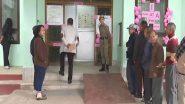Pithoragarh, Jul 1 (PTI) Kunwar Singh Kutiyal complains there are no Indian mobile towers within several kilometres of Uttarakhand's Vyas Valley, near the Indo-Nepal border, where he lives, and he has to depend on Nepalese infrastructure to connect to the world outside.
A resident of Kuti village of the Valley, he said he noticed that the Nepalese government recently provided Wi-Fi facilities in Changru village on its side of the border to strengthen communication for their security personnel deputed at a post there.
“We also need such facilities in our villages. We need to depend only on Indian communication facilities,” he said.
Kutiyal is not a lone voice pressing this demand. He represents thousands of villagers of three localities -- Vyas Valley, Chaundas valley and Dharchula sub-division -- in this district who have no connectivity due to the lack of Indian mobile towers.
Some of them somehow manage to procure Nepalese SIM cards and use them to get Internet and phone connectivity by latching onto Nepalese network.
“Around 40,000 villagers in about 40 villages in these localities have no connectivity. Around 3,000 of them rely on Nepalese Internet connection,” Dharchula Sub-Divisional Magistrate AK Shukla said on Tuesday.
He said that poor connectivity also hampers implementation of flagship government schemes in the border villages.
"Due to the lack of proper network facilities in most parts of Dharchula sub-division, payments related to MGNREGA works cannot be made to the beneficiaries nor can online classes be held in sub-divisional schools," Shukla said.
“We need a strong and dependable network for communication at Dharchula border with Nepal,” the SDM said.
The Vyas Valley is adjacent to Indian territory of Kalapani, which Nepal recently claimed as its own.
Villagers have approached the administration several times in the past with the demand to bolster mobile network infrastructure and submitted a number of memorandums, Shukla said.
There is just one low-capacity BSNL mobile tower at Dharchula which barely meets even the town's requirements, he said.
A section has tried to justify the poor connectivity, saying it is meant to deny Internet access to smugglers and criminals operating in the border, but it does not hold much ground as Nepalese network is widely available in the area, Shukla said.
“In the light of these facts, the communication policy at the Indo-Nepal border needs to be reviewed as better communication facilities to border people is the need of the hour,” the SDM said.
The Congress MLA from Dharchula, Harish Dhami, said he has offered his MLA funds to create communication facility in the area.
“I am ready to give whatever money is required for installing basic infrastructure of communication at the Indo-Nepal and India-China border,” Dhami said.
According to residents of the Vyas Valley, three Nepalese mobile companies cover around 186 km length (north-south), from Kalapani to Pancheshwar, with their mobile towers at different locations.
According to Krishna Garbiyal, a resident of Garbiyang village in Vyas Valley, they get strong Nepalese network up to 15 km inside Indian territory.
MS Waldia, a retired army colonel, said Indian citizens using Nepalese SIM cards and networks poses a threat to national security.
“The government should pay more attention to the communication needs of border villages in view of Nepal's recent aggressiveness towards India,” said Waldia.
Almora MP Ajay Tamta said BSNL is conducting a survey in the area to assess communication needs of people.
“As soon as the survey gets completed, work on installing towers will be started,” Tamta said.
India Nepal relations hit a rough patch recently after Nepal completed the process of redrawing the country's political map through a Constitutional amendment, incorporating three strategically important Indian areas -- Lipulekh, Kalapani and Limpiyadhura.
India has termed as "untenable" the "artificial enlargement" of the territorial claims by Nepal.
(This is an unedited and auto-generated story from Syndicated News feed, LatestLY Staff may not have modified or edited the content body)














 Quickly
Quickly















